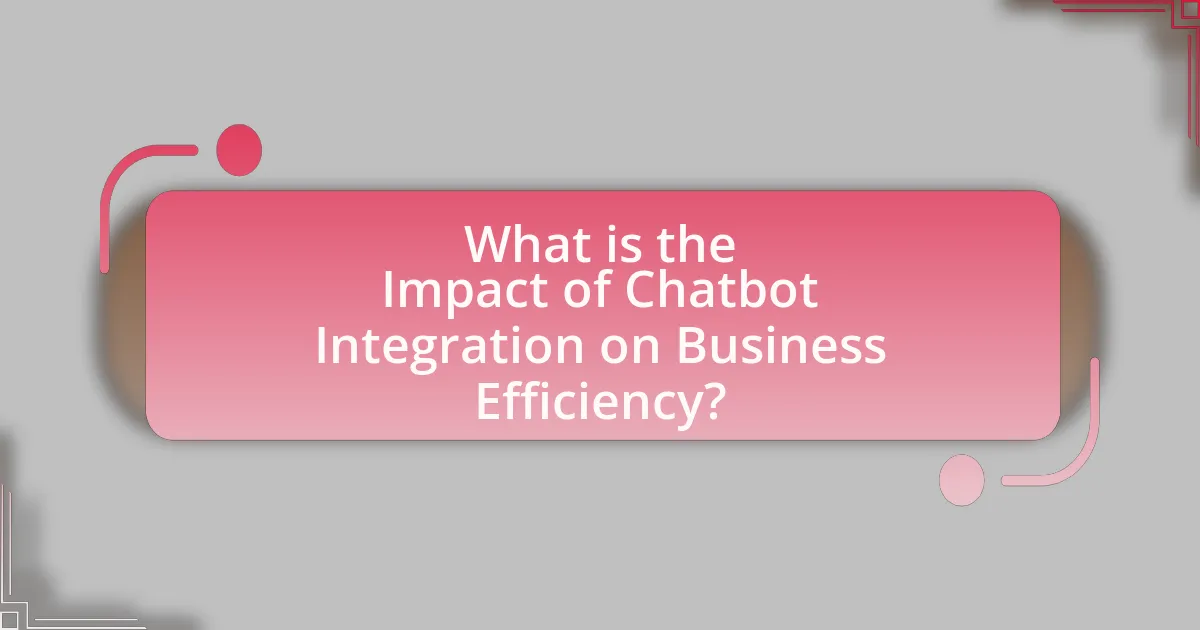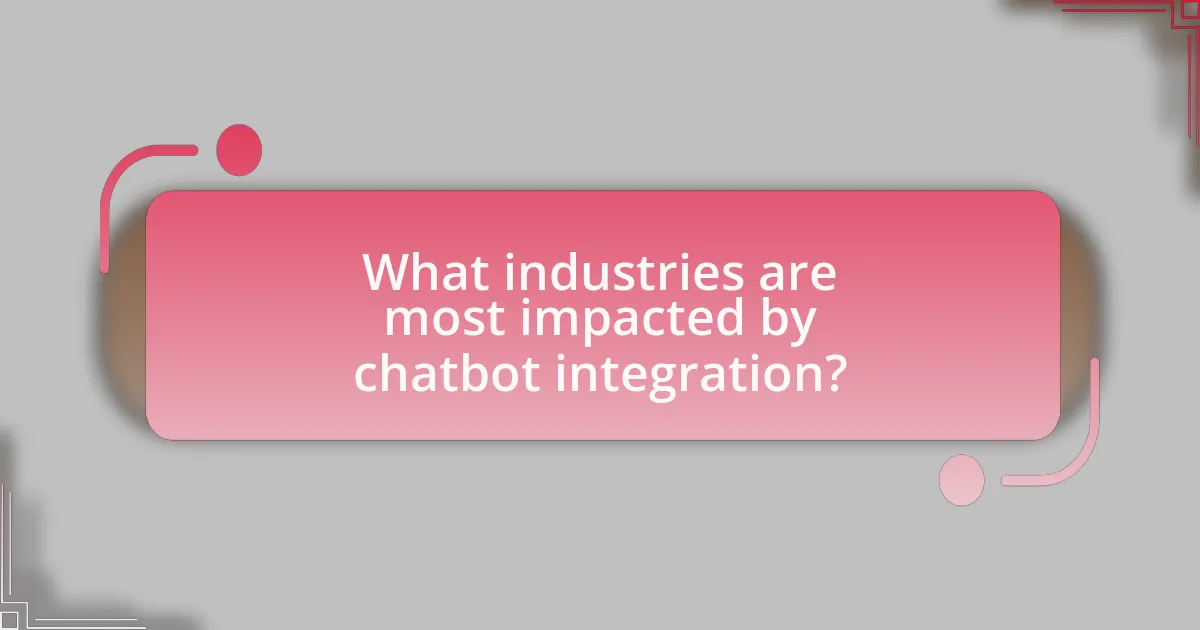Chatbot integration significantly enhances business efficiency by automating customer interactions and streamlining operations. This technology allows businesses to reduce response times, handle a higher volume of inquiries, and provide 24/7 support, leading to improved customer satisfaction and substantial cost savings. Key benefits include the automation of routine tasks, increased operational efficiency, and enhanced customer retention rates. The article explores how chatbots function within various industries, the specific tasks they can automate, and the measurable impacts on operational workflows and customer service. Additionally, it addresses the challenges businesses face during integration and outlines best practices for successful implementation.

What is the Impact of Chatbot Integration on Business Efficiency?
Chatbot integration significantly enhances business efficiency by automating customer interactions and streamlining operations. Businesses that implement chatbots can reduce response times and handle a higher volume of inquiries simultaneously, leading to improved customer satisfaction. For instance, a study by Juniper Research found that chatbots could save businesses over $8 billion annually by 2022 through reduced operational costs and increased productivity. Additionally, chatbots can operate 24/7, allowing companies to provide continuous support without the need for additional staffing, further optimizing resource allocation.
How do chatbots enhance operational workflows?
Chatbots enhance operational workflows by automating routine tasks and facilitating real-time communication. This automation reduces the workload on human employees, allowing them to focus on more complex tasks that require critical thinking and creativity. For instance, chatbots can handle customer inquiries, process orders, and provide instant support, which streamlines operations and improves response times. According to a study by IBM, businesses can save up to 30% in operational costs by implementing chatbots for customer service functions. This efficiency not only accelerates workflow but also enhances customer satisfaction, as users receive immediate assistance without long wait times.
What specific tasks can chatbots automate in a business setting?
Chatbots can automate various tasks in a business setting, including customer support, lead generation, appointment scheduling, and order processing. By handling customer inquiries through instant responses, chatbots reduce the workload on human agents, allowing them to focus on more complex issues. For instance, a study by IBM found that chatbots can answer up to 80% of routine questions, significantly improving response times and customer satisfaction. Additionally, chatbots can qualify leads by engaging potential customers and collecting relevant information, which streamlines the sales process. In appointment scheduling, chatbots can manage calendars and send reminders, enhancing operational efficiency. Furthermore, they can facilitate order processing by guiding customers through the purchasing journey, thus increasing conversion rates.
How do chatbots improve response times for customer inquiries?
Chatbots improve response times for customer inquiries by providing instant, automated replies to common questions. This technology enables businesses to handle multiple inquiries simultaneously, reducing wait times significantly. According to a study by Juniper Research, chatbots can save businesses up to 2.5 billion hours in customer service time annually by automating responses, which leads to faster resolution of customer issues. Additionally, chatbots operate 24/7, ensuring that customers receive immediate assistance regardless of the time of day, further enhancing overall efficiency in customer service operations.
What are the measurable benefits of chatbot integration?
Chatbot integration provides measurable benefits such as increased operational efficiency, enhanced customer satisfaction, and cost savings. Businesses that implement chatbots can automate up to 80% of routine inquiries, allowing human agents to focus on more complex tasks. According to a study by Juniper Research, chatbots are projected to save businesses over $8 billion annually by 2022 through reduced operational costs. Additionally, chatbots can improve response times, with 64% of consumers stating that 24/7 service is the best feature of chatbots, leading to higher customer satisfaction rates. These metrics demonstrate the tangible advantages of integrating chatbots into business operations.
How does chatbot integration affect cost savings for businesses?
Chatbot integration significantly reduces operational costs for businesses by automating customer service tasks. By handling routine inquiries and providing 24/7 support, chatbots decrease the need for extensive human staffing, leading to lower labor costs. For instance, a study by Juniper Research estimates that chatbots will help businesses save over $8 billion annually by 2022 through reduced customer service costs. Additionally, chatbots enhance efficiency by resolving issues faster than human agents, which can lead to increased customer satisfaction and retention, further contributing to cost savings.
What impact do chatbots have on customer satisfaction and retention?
Chatbots significantly enhance customer satisfaction and retention by providing immediate responses and 24/7 availability. Research indicates that businesses utilizing chatbots can achieve a 70% reduction in response time, leading to improved customer experiences. Additionally, a study by Juniper Research found that chatbots can increase customer retention rates by up to 30% due to their ability to handle inquiries efficiently and personalize interactions. This efficiency not only meets customer expectations but also fosters loyalty, as customers appreciate quick and effective service.

How does chatbot technology function within a business?
Chatbot technology functions within a business by automating customer interactions and providing instant responses to inquiries. This automation allows businesses to handle a high volume of customer queries simultaneously, reducing wait times and improving customer satisfaction. For instance, a study by Juniper Research predicts that chatbots will save businesses over $8 billion annually by 2022 through enhanced efficiency and reduced operational costs. Additionally, chatbots can gather data on customer preferences and behaviors, enabling businesses to tailor their services and marketing strategies effectively.
What are the key components of chatbot systems?
The key components of chatbot systems include natural language processing (NLP), machine learning algorithms, a knowledge base, user interface, and integration capabilities. Natural language processing enables chatbots to understand and interpret user inputs in human language, while machine learning algorithms allow them to improve responses over time based on interactions. A knowledge base provides the information that the chatbot uses to answer queries accurately. The user interface is crucial for facilitating interaction between the user and the chatbot, ensuring a seamless experience. Lastly, integration capabilities allow chatbots to connect with other systems and platforms, enhancing their functionality and effectiveness in business operations.
How do natural language processing and machine learning contribute to chatbot effectiveness?
Natural language processing (NLP) and machine learning (ML) significantly enhance chatbot effectiveness by enabling them to understand and respond to user queries more accurately. NLP allows chatbots to interpret human language, including nuances, context, and intent, which leads to more relevant and coherent interactions. For instance, a study by McTear (2017) highlights that NLP techniques improve the ability of chatbots to handle diverse user inputs, resulting in higher user satisfaction rates.
Machine learning further optimizes chatbot performance by allowing them to learn from past interactions and improve over time. This adaptive learning process enables chatbots to refine their responses based on user feedback and behavior patterns, making them more efficient in addressing customer needs. Research by Adamopoulou and Moussiades (2020) indicates that chatbots utilizing ML algorithms can achieve up to 90% accuracy in understanding user intents, thereby enhancing their overall effectiveness in business applications.
What role does data analytics play in optimizing chatbot performance?
Data analytics plays a crucial role in optimizing chatbot performance by enabling the continuous improvement of interactions and user satisfaction. By analyzing user data, such as conversation logs and engagement metrics, businesses can identify patterns in user behavior, pinpoint common issues, and assess the effectiveness of responses. For instance, a study by Salesforce found that companies using data analytics to refine their chatbots experienced a 30% increase in customer satisfaction scores. This data-driven approach allows for targeted adjustments, such as refining natural language processing algorithms and enhancing response accuracy, ultimately leading to more efficient and effective chatbot interactions.
What challenges do businesses face when integrating chatbots?
Businesses face several challenges when integrating chatbots, including technical limitations, user acceptance, and data privacy concerns. Technical limitations arise from the need for seamless integration with existing systems, which can be complex and resource-intensive. User acceptance is critical, as customers may prefer human interaction over automated responses, leading to potential dissatisfaction. Data privacy concerns are heightened due to the sensitive nature of information handled by chatbots, necessitating robust security measures to comply with regulations like GDPR. These challenges can hinder the effectiveness of chatbot integration and impact overall business efficiency.
How can businesses overcome resistance to adopting chatbot technology?
Businesses can overcome resistance to adopting chatbot technology by providing comprehensive training and demonstrating the technology’s value through pilot programs. Training equips employees with the necessary skills to utilize chatbots effectively, addressing fears of job displacement and enhancing user confidence. Pilot programs allow businesses to showcase tangible benefits, such as improved customer service response times and increased operational efficiency, which can lead to a 30% reduction in customer service costs, as reported by Gartner. By combining education and practical demonstrations, businesses can foster a culture of acceptance and innovation regarding chatbot technology.
What are common technical issues encountered during chatbot implementation?
Common technical issues encountered during chatbot implementation include integration challenges, natural language processing limitations, and data privacy concerns. Integration challenges arise when chatbots must connect with existing systems, which can lead to compatibility issues and increased complexity. Natural language processing limitations can result in misunderstandings or incorrect responses, as chatbots may struggle to accurately interpret user intent or context. Data privacy concerns are critical, as businesses must ensure compliance with regulations like GDPR while handling user data securely. These issues can hinder the effectiveness of chatbots and impact overall business efficiency.

What industries are most impacted by chatbot integration?
The industries most impacted by chatbot integration include retail, healthcare, finance, and customer service. In retail, chatbots enhance customer engagement and streamline the purchasing process, leading to increased sales; for instance, a study by Juniper Research predicts that chatbots will save businesses over $8 billion annually by 2022 through improved customer service. In healthcare, chatbots assist in patient scheduling and provide medical information, improving operational efficiency and patient satisfaction. The finance sector utilizes chatbots for customer inquiries and transaction processing, which reduces wait times and operational costs. Lastly, in customer service, chatbots handle routine inquiries, allowing human agents to focus on complex issues, thereby increasing overall productivity.
How do different sectors utilize chatbots for efficiency?
Different sectors utilize chatbots to enhance efficiency by automating customer interactions, streamlining operations, and providing instant support. In the retail sector, chatbots handle customer inquiries and facilitate transactions, resulting in a 30% reduction in response time and increased sales. In healthcare, chatbots assist with appointment scheduling and patient triage, improving patient flow and reducing administrative workload by up to 40%. The banking sector employs chatbots for transaction inquiries and fraud detection, which can decrease operational costs by 20% while enhancing customer satisfaction. These applications demonstrate how chatbots contribute to operational efficiency across various industries.
What specific use cases exist for chatbots in retail?
Chatbots in retail serve several specific use cases, including customer service, personalized shopping assistance, order tracking, and inventory management. Customer service chatbots handle inquiries and complaints, providing instant responses and reducing wait times, which enhances customer satisfaction. Personalized shopping assistants use customer data to recommend products, improving the shopping experience and increasing sales. Order tracking chatbots provide real-time updates on shipment status, reducing customer anxiety and improving transparency. Additionally, chatbots assist in inventory management by automating stock level inquiries and reordering processes, which streamlines operations and reduces human error. These use cases demonstrate how chatbots can significantly enhance business efficiency in the retail sector.
How are chatbots transforming customer service in the healthcare industry?
Chatbots are transforming customer service in the healthcare industry by providing instant responses to patient inquiries, thereby enhancing accessibility and efficiency. These AI-driven tools can handle a high volume of queries simultaneously, reducing wait times for patients seeking information about appointments, medications, and general health advice. For instance, a study by Accenture found that 77% of patients are willing to use chatbots for appointment scheduling and medication reminders, indicating a strong acceptance of this technology. Additionally, chatbots can operate 24/7, ensuring that patients receive support outside of traditional office hours, which is crucial for urgent health-related questions. This integration not only improves patient satisfaction but also allows healthcare providers to allocate resources more effectively, ultimately leading to increased operational efficiency.
What future trends can we expect in chatbot technology?
Future trends in chatbot technology include enhanced natural language processing, increased personalization, and integration with advanced AI systems. Enhanced natural language processing will enable chatbots to understand and respond to user queries with greater accuracy, as evidenced by the advancements seen in models like OpenAI’s GPT-3, which can generate human-like text. Increased personalization will allow chatbots to tailor interactions based on user data, improving customer satisfaction and engagement. Additionally, integration with advanced AI systems, such as machine learning algorithms, will enable chatbots to learn from interactions and improve over time, leading to more efficient business operations. These trends are supported by the growing demand for automated customer service solutions, projected to reach $1.34 billion by 2024, according to a report by Business Insider.
How will advancements in AI influence the capabilities of chatbots?
Advancements in AI will significantly enhance the capabilities of chatbots by enabling them to understand and process natural language more effectively. Improved natural language processing (NLP) algorithms will allow chatbots to interpret user intent with greater accuracy, leading to more relevant and context-aware responses. For instance, the integration of deep learning techniques has already shown a marked improvement in sentiment analysis and contextual understanding, as evidenced by the performance of models like OpenAI’s GPT-3, which can generate human-like text based on user prompts. This evolution in AI technology will empower chatbots to handle complex queries, engage in multi-turn conversations, and provide personalized experiences, ultimately increasing their utility in business settings and enhancing overall efficiency.
What emerging technologies could enhance chatbot integration in businesses?
Emerging technologies that could enhance chatbot integration in businesses include artificial intelligence (AI), natural language processing (NLP), machine learning (ML), and voice recognition. AI enables chatbots to understand and respond to customer inquiries more effectively, while NLP allows for more human-like interactions by interpreting user intent and context. Machine learning enhances chatbots’ ability to learn from past interactions, improving their responses over time. Voice recognition technology facilitates hands-free communication, making it easier for users to interact with chatbots. According to a report by Gartner, by 2025, 75% of customer service interactions will be powered by AI, indicating a significant shift towards these technologies in enhancing chatbot capabilities.
What best practices should businesses follow for successful chatbot integration?
Businesses should follow several best practices for successful chatbot integration, including defining clear objectives, ensuring seamless user experience, and continuously monitoring performance. Defining clear objectives helps businesses understand the specific problems the chatbot will solve, which can lead to improved customer satisfaction and operational efficiency. Ensuring a seamless user experience involves designing intuitive interactions and providing easy access to human support when needed, which enhances user engagement and retention. Continuously monitoring performance through analytics allows businesses to identify areas for improvement and adapt the chatbot’s capabilities, leading to better service delivery. These practices are supported by research indicating that companies that implement structured chatbot strategies see a 30% increase in customer engagement and a 25% reduction in operational costs.










